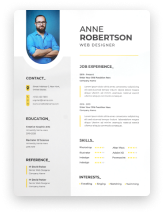As a business analyst, your resume is the key to unlocking new career opportunities in the fast-paced world of business and finance. In this comprehensive guide, we'll walk you through the essential steps to create a resume that showcases your analytical skills, business acumen, and ability to drive data-driven decisions. From crafting a compelling summary to highlighting your technical expertise, we'll provide you with practical tips and real-world examples to help you stand out from the competition and land your dream job.

Business Analyst Resume Example
Olivia Thompson
New York, NY | (212) 555-1234
olivia.thompson@email.com
www.linkedin.com/in/oliviathompson
Summary
Analytical and detail-oriented Business Analyst with 5+ years of experience in driving data-driven decisions and optimizing business processes. Proven track record of collaborating with cross-functional teams to identify and implement solutions that improve efficiency and profitability. Skilled in data analysis, requirements gathering, and project management.
Professional Experience
Senior Business Analyst
Deloitte, New York, NY
July 2020 - Present
- Lead requirements gathering sessions with stakeholders to understand business needs and translate them into functional specifications
- Analyze complex datasets using SQL and Tableau to uncover insights and provide data-driven recommendations to senior management
- Collaborate with IT teams to design and implement process improvements, resulting in a 20% increase in operational efficiency
- Manage projects from initiation to completion, ensuring timely delivery and adherence to budget constraints
Business Analyst
PwC, New York, NY
June 2018 - June 2020
- Conducted market research and competitor analysis to identify new business opportunities and support strategic decision-making
- Developed and maintained dashboards and reports using Power BI to track key performance indicators and monitor project progress
- Facilitated workshops with business users to document current processes and identify areas for improvement
- Assisted in the development of business cases and ROI analyses for proposed initiatives
Education
Master of Business Administration (MBA)
New York University Stern School of Business
New York, NY
2018
Bachelor of Science in Business Administration
University of California, Berkeley, CA
2016
Skills
- Business Analysis
- Data Analysis
- SQL
- Tableau
- Power BI
- Project Management
- Requirements Gathering
- Process Improvement
- Stakeholder Management
Certifications
- Certified Business Analysis Professional (CBAP)
- Project Management Professional (PMP)
Structuring Your Business Analyst Resume for Maximum Impact
When it comes to crafting a compelling business analyst resume, structure and organization are key. A well-structured resume not only makes it easy for hiring managers to quickly scan and understand your qualifications but also helps to highlight your most relevant skills and experiences. Here are some essential tips for structuring your business analyst resume:
-
Start with a clear and concise summary: Begin your resume with a brief summary that encapsulates your key strengths, experience, and career objectives. This section should be tailored to the specific job you're applying for and should immediately capture the attention of the reader.
-
Prioritize relevant work experience: When listing your professional experience, start with your most recent and relevant roles. For each position, include the company name, your job title, dates of employment, and a few bullet points that highlight your key responsibilities and achievements. Focus on quantifiable results and use action verbs to describe your contributions.
-
Showcase your technical skills: As a business analyst, you likely possess a range of technical skills, such as proficiency in data analysis tools, programming languages, and project management methodologies. Make sure to include a dedicated skills section that lists your core competencies and any relevant certifications or training.
-
Highlight your education and certifications: Include your educational background, focusing on your highest degree and any relevant coursework or projects. If you have obtained any professional certifications, such as the Certified Business Analysis Professional (CBAP) or Project Management Professional (PMP), make sure to list them prominently on your resume.
-
Use clear and consistent formatting: Choose a clean, professional font and use consistent formatting throughout your resume. Use bullet points to break up long paragraphs and make your resume easy to read. Ensure that your section headings are bold and easily distinguishable from the rest of the text.
By following these structuring tips, you can create a business analyst resume that effectively showcases your skills and experience and increases your chances of landing an interview.
Crafting a Compelling Business Analyst Resume Summary or Objective
Your resume summary or objective is the first thing a hiring manager will read, so it's crucial to make a strong impression. This section should be a concise and compelling overview of your skills, experience, and career goals, tailored to the specific business analyst role you're applying for.
When deciding between a summary or objective, consider your level of experience:
- If you have several years of business analysis experience, opt for a summary that highlights your key strengths and accomplishments.
- If you are new to the field or making a career change, an objective statement can help explain your goals and how your skills transfer to a business analyst role.
Example of a strong business analyst resume summary:
Results-driven Business Analyst with 5+ years of experience in financial services. Proven track record of leading process improvement initiatives and delivering data-driven insights to support strategic decision-making. Skilled in requirements gathering, data analysis, and stakeholder management. Seeking to leverage my expertise to drive operational efficiency and profitability for [Company Name].
Example of a weak business analyst resume summary:
Business Analyst with experience in finance looking for a new opportunity. Skilled in many areas and able to learn quickly. Hoping to join a dynamic team and make a positive impact.
Some key elements to include in your business analyst resume summary or objective:
- Years of experience in business analysis or a related field
- Industry expertise (e.g., financial services, healthcare, technology)
- Key skills and competencies (e.g., data analysis, process improvement, project management)
- Significant achievements or projects you've led
- Certifications or training in relevant tools and methodologies
By crafting a targeted and compelling summary or objective, you can grab the attention of hiring managers and set the stage for a strong business analyst resume.
Highlighting Your Business Analyst Work Experience
The work experience section is the core of your business analyst resume, where you can showcase your practical skills and achievements. When describing your professional experience, focus on the impact you've made in previous roles and how your contributions have driven business success.
Some tips for crafting compelling work experience bullet points:
- Use action verbs to describe your responsibilities and accomplishments, such as "analyzed," "developed," "implemented," or "optimized."
- Quantify your achievements whenever possible, using metrics such as cost savings, revenue growth, or efficiency improvements.
- Highlight your role in collaborating with cross-functional teams and stakeholders to deliver projects and initiatives.
- Emphasize your experience with relevant tools and technologies, such as SQL, Tableau, or Agile methodologies.
Example of effective work experience bullet points:
Business Analyst
ABC Financial Services
New York, NY
June 2018 - Present
- Led requirements gathering and analysis for a client onboarding system, resulting in a 30% reduction in onboarding time and a 20% increase in client satisfaction.
- Conducted data analysis using SQL and Tableau to identify opportunities for process improvement, presenting findings to senior leadership and driving the implementation of solutions.
- Collaborated with cross-functional teams to develop and launch a new mobile banking app, contributing to a 15% increase in mobile transactions and a 10% boost in customer retention.
- Managed a portfolio of projects using Agile methodologies, ensuring on-time and on-budget delivery while maintaining high quality standards.
Additionally, if you have experience in a particular industry or domain, such as healthcare or e-commerce, be sure to emphasize this expertise and how it has informed your work as a business analyst.
Remember, your work experience section should paint a picture of your growth and progression as a business analyst, demonstrating how you've taken on increasing levels of responsibility and delivered value to your previous employers.
Showcasing Your Business Analyst Education and Certifications
While your work experience is the most critical component of your business analyst resume, your education and certifications can also play a significant role in setting you apart from other candidates. This section should highlight your relevant academic background and any professional development courses or certifications you've completed.
When listing your education, include:
- The name of the institution
- The degree earned (e.g., Bachelor of Science in Business Administration)
- Your major or concentration
- Graduation year
- Any relevant coursework, projects, or academic honors
Example of an education section:
Master of Business Administration (MBA)
New York University Stern School of Business
New York, NY
Concentration: Business Analytics
Graduation Year: 2018
Bachelor of Science in Business Administration
University of California, Berkeley, CA
Major: Finance
Graduation Year: 2014
- Relevant Coursework:
- Data Analysis for Business,
- Project Management,
- Operations Management
In addition to your formal education, include any professional certifications you've earned that are relevant to business analysis or your industry. Some common certifications for business analysts include:
- Certified Business Analysis Professional (CBAP)
- PMI Professional in Business Analysis (PMI-PBA)
- Agile Certified Practitioner (ACP)
- Certified Scrum Product Owner (CSPO)
- Six Sigma Green Belt or Black Belt
Example of a certifications section:
Certifications:
- Certified Business Analysis Professional (CBAP), IIBA, 2020
- Agile Certified Practitioner (ACP), PMI, 2019
- Six Sigma Green Belt, ASQ, 2018
Remember, while your education and certifications are important, they should complement your work experience and skills. Be sure to tie your academic background and professional development to the specific requirements of the business analyst role you're seeking, demonstrating how your knowledge and training have prepared you for success in the position.
Showcasing Your Business Analyst Skills and Expertise
Your skills section is where you can highlight the specific tools, technologies, and methodologies you bring to the table as a business analyst. This section should be tailored to the job posting, emphasizing the skills that are most relevant to the role and the company's needs.
Some key skills to consider including:
- Business analysis methodologies: Agile, Scrum, Lean, Six Sigma
- Data analysis and visualization tools: SQL, Excel, Tableau, Power BI
- Requirements gathering and management: User stories, use cases, wireframing
- Project management: Jira, Trello, Microsoft Project
- Programming and querying languages: SQL, Python, R
- Soft skills: Communication, collaboration, problem-solving, critical thinking
Example of a skills section for a business analyst resume:
Skills
- Business Analysis:
- Agile,
- Scrum,
- Lean,
- Six Sigma
- Data Analysis:
- SQL,
- Excel,
- Tableau,
- Power BI
- Requirements Management:
- User stories,
- use cases,
- wireframing
- Project Management:
- Jira,
- Trello,
- Microsoft Project
- Programming: SQL, Python
- Soft Skills: Communication, collaboration, problem-solving, critical thinking
In addition to listing your skills, consider providing concrete examples of how you've applied them in your work experience section. This helps demonstrate your proficiency and showcases the impact you've made in previous roles.
Remember, while it's essential to showcase a diverse range of skills, be honest about your proficiency level. Only include skills that you feel comfortable discussing in an interview and applying on the job.
Finally, keep in mind that the skills section is just one part of your overall business analyst resume. Be sure to integrate your skills throughout your work experience and education sections as well, creating a cohesive picture of your capabilities and expertise.
Enhancing Your Business Analyst Resume with Additional Sections
While your work experience, education, and skills are the core components of your business analyst resume, adding additional sections can help you stand out from other candidates and showcase your unique qualifications. Here are a few sections to consider including:
-
Certifications: If you have earned any relevant certifications, such as the Certified Business Analysis Professional (CBAP) or Agile Certified Practitioner (ACP), create a separate section to highlight these achievements.
-
Projects: If you have completed any notable projects outside of your formal work experience, such as a capstone project for your degree or a freelance consulting engagement, consider including a "Projects" section to showcase your initiative and problem-solving skills.
-
Volunteer Experience: If you have volunteered your business analysis skills for a nonprofit organization or community group, include this experience to demonstrate your leadership and social responsibility.
-
Professional Associations: If you are a member of any professional associations, such as the International Institute of Business Analysis (IIBA) or the Project Management Institute (PMI), list your memberships to show your engagement with the broader business analysis community.
-
Publications or Speaking Engagements: If you have published articles or given presentations on business analysis topics, include a section highlighting these accomplishments to establish your thought leadership and expertise.
Example of additional sections for a business analyst resume:
Certifications
- Certified Business Analysis Professional (CBAP), IIBA, 2020
- Agile Certified Practitioner (ACP), PMI, 2019
Projects
- Volunteer Business Analyst, ABC Nonprofit, 2018-2019
- Conducted a process improvement analysis for the organization's client intake system, resulting in a 25% reduction in processing time and improved client satisfaction.
Professional Associations
- Member, International Institute of Business Analysis (IIBA), 2017-Present
- Member, Project Management Institute (PMI), 2018-Present
Remember, the goal of your business analyst resume is to paint a comprehensive picture of your qualifications and experience, demonstrating why you are the ideal candidate for the position. By carefully curating your additional sections, you can create a more compelling and memorable application that sets you apart from the competition.
Crafting a Compelling Business Analyst Cover Letter
While your resume is the foundation of your job application, a well-written cover letter can be the key to setting yourself apart from other candidates. Your business analyst cover letter should complement your resume, providing additional context and highlighting your most relevant qualifications and experiences.
Here are some tips for crafting a compelling cover letter:
-
Start with a strong opening: Begin your cover letter with a compelling hook that grabs the reader's attention and communicates your enthusiasm for the role. Consider highlighting a key achievement or explaining why you're passionate about business analysis.
-
Tailor your content to the job posting: Just like your resume, your cover letter should be tailored to the specific business analyst role you're applying for. Use the job posting as a guide, highlighting the skills and experiences that are most relevant to the position.
-
Provide specific examples: Use your cover letter to provide concrete examples of your business analysis experience and achievements. Focus on the impact you've made in previous roles and how your skills and expertise can benefit the company you're applying to.
-
Showcase your personality: While your cover letter should be professional, it's also an opportunity to let your personality shine through. Use a conversational tone and share details that demonstrate your passion for business analysis and your fit with the company culture.
-
Close with a call to action: End your cover letter with a strong closing that reiterates your interest in the role and encourages the reader to take action. Consider thanking them for their consideration and expressing your eagerness to discuss your qualifications further in an interview.
Example of a compelling business analyst cover letter opening:
Dear [Hiring Manager],
As a passionate and results-driven Business Analyst with over five years of experience in the financial services industry, I was thrilled to come across the open position at [Company Name]. With my proven track record of driving process improvements and delivering data-driven insights, I am confident that I would be a valuable asset to your team.
Remember, your cover letter is your chance to make a strong first impression and convince the hiring manager that you're the ideal candidate for the business analyst role. By tailoring your content, showcasing your personality, and highlighting your most relevant qualifications, you can create a compelling cover letter that sets you apart from other applicants and increases your chances of landing an interview.

Key Takeaways for Creating a Standout Business Analyst Resume
-
Start with a clear and concise summary that highlights your key strengths, experience, and career objectives, tailored to the specific business analyst role you're applying for.
-
Structure your resume strategically, prioritizing relevant work experience and showcasing your technical skills and certifications.
-
Use action verbs and quantifiable achievements to describe your responsibilities and impact in previous roles.
-
Tailor your skills section to the job posting, emphasizing the tools, technologies, and methodologies most relevant to the position.
-
Consider including additional sections, such as projects, volunteer experience, or professional associations, to showcase your unique qualifications and expertise.
-
Complement your resume with a compelling cover letter that highlights your most relevant experiences, provides specific examples of your impact, and demonstrates your passion for business analysis.
By following these key strategies and tips, you can create a standout business analyst resume and cover letter that effectively communicates your value proposition and increases your chances of landing your dream job in the competitive field of business analysis.
Frequently Asked Questions About Business Analyst Resumes
-
Q: How long should my business analyst resume be?
A: In most cases, a business analyst resume should be limited to 1-2 pages. Focus on concise, relevant information that showcases your key qualifications and achievements.
-
Q: Should I include a photo on my business analyst resume?
A: Unless specifically requested, it's generally best to avoid including a photo on your resume. Keep the focus on your professional experience and skills.
-
Q: How should I handle gaps in my employment history?
A: If you have gaps in your employment history, consider including any relevant volunteer work, freelance projects, or professional development courses you completed during that time. Be prepared to address any gaps directly in your cover letter or interview.
-
Q: Should I include references on my business analyst resume?
A: It's not necessary to include references on your initial resume. Instead, have a separate list of references ready to provide upon request.
-
Q: How can I make my business analyst resume stand out?
A: To make your resume stand out, focus on quantifiable achievements, tailor your content to the specific job posting, and showcase your unique mix of technical and soft skills. Consider using a clean, modern design template to create a visually appealing and easy-to-read document.
-
Q: Should I include non-business analyst experience on my resume?
A: If you have relevant experience in other fields, such as project management or data analysis, consider including it on your resume. However, prioritize the experience that is most directly applicable to the business analyst role you're seeking.
-
Q: How often should I update my business analyst resume?
A: It's a good idea to review and update your resume regularly, even if you're not actively seeking a new job. Aim to refresh your resume at least once every six months, adding any new skills, certifications, or achievements you've acquired.
By anticipating and addressing these common questions, you can create a comprehensive and effective business analyst resume that positions you for success in your job search.
Recommended Reading









